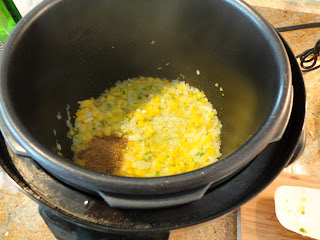Earlier in the week, I made the caramel sauce. It was an interesting and fun experiment, with excellent results, but if you don't want to fuss with making caramel, you could certainly use any good quality caramel sauce on the market. The process of caramelizing sugar is a matter of zen-like patience followed by quick and decisive action.
sugar, just beginning to color
To two and half cups of sugar in a deep sauce pan, add a couple of tablespoons of white corn syrup, and a quarter cup of water. The corn syrup isn't absolutely necessary, but from what I read, it will prevent the sugar from "seizing", which is when the melted sugar instantly turns into a crystalline mass, and you must toss it out and start over. From what I read on the net, this is an all too common problem, so in went the corn syrup, and I had no problems.
Beware, caramelizing sugar is a lava-like substance, capable of trip-to-the-hospital, disfiguring burns. Hence, the deep pot, and great care to keep the handle on the pan turned away from the edge of the stove. While the sugar dissolves and begins to heat up and boil, you really need to do very little, besides give the pan a gentle little swirl on occasion, to be sure the sugar is melting evenly. Patience is rewarded. My sugar stayed utterly clear, with no signs of caramelizing until it was over 300 degrees. Once it started to brown, it darkened very quickly.
for deep caramel flavor, the trick is to take the sugar
to a deep shade of brown, and get it off the heat
before it goes from dark brown to burnt
Now comes the fun part. With the sugar off of the heat, pour a generous cup of cream down the side of the pan, and watch the action.
the sugar boils violently with the addition of the cream,
but no worries -- all that action stays
in the bottom of the pot
Once the cream mixture has calmed down a bit, put it back on low heat, and stir gently, until the sugar and cream have fully integrated into a soft sauce.
swirling in a couple of tablespoons of butter
adds richness and gloss
Butter is optional, but just a couple of tablespoons really does add to the caramel. Same goes with a generous pinch of salt, which adds balance to all that sweetness. Once it has cooled completely, it is simple to incorporate into an apple pie. Or just to simply dip into with some crunchy apple slices, for that matter...
For the pie, I used a couple of granny smiths, along with a honeycrisp, for a little flavor variation. I used a mandoline to slice them very thin, spritzed them with a bit of lemon juice, and coated them with the caramel, and a couple of tablespoons of tapioca flour that I found in the international foods at whole foods -- it makes a great thickener for fruit pies.
caramel and apples -- one of those perfect marriages
The apples exuded quite a bit of water, which watered down the caramel a bit. If I make this pie again, I will strain the excess sauce off of the apple slices, and boil it down to a syrup before adding it back to the apples. I suppose you could precook the apples in the syrup, but I don't care for the very soft texture that lends the apples in the baked pie. At any rate, the free form tart turned lovely and luscious, served with a little extra caramel drizzle on top.



















































